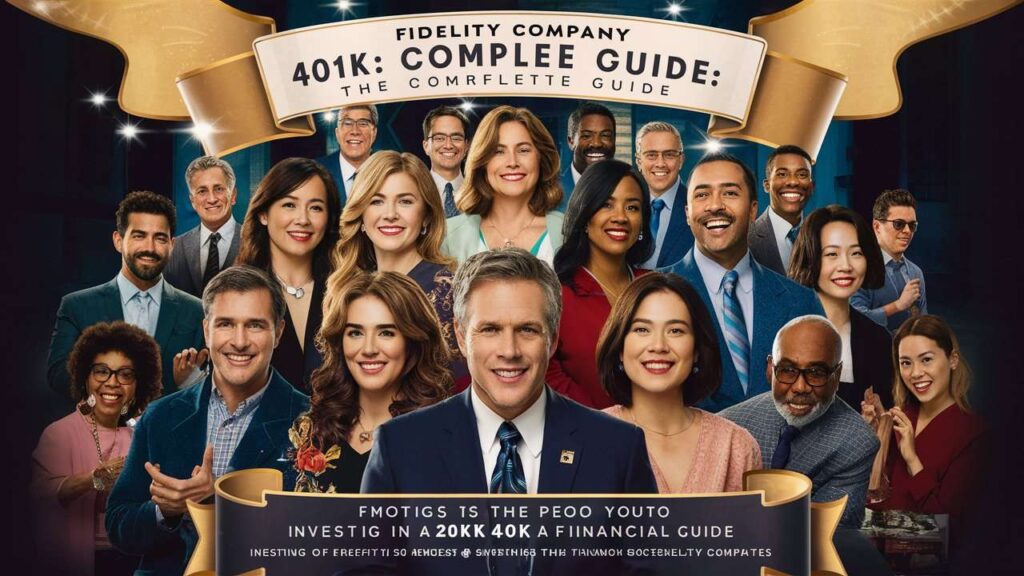What Exactly Is a 401k, and Why Should You Care?
A 401k is like your financial safety net for retirement. It’s a tax-advantaged savings plan offered by employers, and trust me, you want one. Not only does it let you stash away money before Uncle Sam gets his hands on it, but your employer might even chip in, too. Think of it as a piggy bank with rocket boosters💸perfect for future you when you’re sipping margaritas on a beach instead of worrying about bills. The earlier you start, the more you can capitalize on its magic.

How Fidelity Company 401k Stands Out from the Crowd
Fidelity’s 401k isn’t just your average run-of-the-mill retirement account. Fidelity brings a robust suite of tools, investment options, and financial guidance, making them a standout in the crowded 401klandscape. With competitive fees, intuitive online platforms, and a reputation for customer service, Fidelity’s 401k is where financial security meets simplicity. Plus, their selection of investment funds? It’s like walking into a candy store, but, you know, for your money.
The Basics: Understanding Your Fidelity 401k Plan
When you open a Fidelity 401k, you’re stepping into a world of financial opportunity. Your contributions are automatically deducted from your paycheck (painless, right?), and you can choose how much to stash away. Fidelity then takes your money and invests it in a variety of options💸stocks, bonds, mutual funds, and more. And the best part? You don’t pay taxes on that money until you withdraw it during retirement. It’s like hiding your savings from the IRS, legally.

Why You Should Start Contributing Yesterday
Time is the best friend of a 401k. The earlier you start contributing, the longer your money has to grow. Waiting until you’re “ready” could cost you thousands in missed compound interest (more on that magic later). Don’t think of it as money you’re missing now💸think of it as future-you’s vacation fund. Trust me, you’ll thank yourself in 30 years when your 401k is plumper than a Thanksgiving turkey.
Matching Contributions: The Free Money You Might Be Ignoring
Ever heard of free money? It exists in the form of employer matching contributions. Many employers will match your contributions up to a certain percentage💸basically doubling your savings without lifting a finger. If you’re not contributing enough to get the full match, you’re leaving money on the table. Imagine turning down free cash at a party. Don’t be that person. Grab it.

Pre-Tax vs Roth 401k: Which One Is Right for You?
The choice between a pre-tax and Roth 401k is like deciding between paying now or later. With a pre-tax 401k, your contributions reduce your taxable income today, but you’ll pay taxes when you withdraw the money in retirement. A Roth 401k, on the other hand, means you pay taxes now and enjoy tax-free withdrawals later. The decision depends on whether you expect to be in a higher tax bracket now or in retirement. Either way, it’s a game of financial chess, and Fidelity has you covered with both options.
How to Enroll in Fidelity’s 401k Without Breaking a Sweat
Signing up for Fidelity’s 401k is easier than online shopping (and arguably more satisfying). Log into your account, follow the prompts, and boom💸you’re enrolled. Fidelity’s user-friendly interface walks you through every step, from setting your contribution percentage to selecting your investment options. You don’t need a finance degree to figure it out. Just a few clicks and you’re on the road to a more secure future.
Maximizing Your Contributions Like a Savings Ninja
If you’re serious about securing a rock-solid retirement, it’s time to channel your inner ninja. Maxing out your contributions, or at least contributing the most your budget allows, is the name of the game. The current annual limit for 401k contributions is $22,500 (though it can change). Every extra dollar you sock away today is one less worry for tomorrow.

What Is a 401k Contribution Limit and Why Does It Matter?
The government sets a cap on how much you can contribute to your 401k each year💸this is known as the contribution limit. While you might not feel like you can reach that lofty $22,500 limit, aiming high is still a good idea. The more you contribute within those limits, the more you benefit from the tax breaks and compound growth over time.
The Magic of Compound Interest: Your 401k’s Best Friend
Compound interest is like the secret sauce of your 401k. It’s interest on your interest💸basically money growing on money. Over time, this exponential growth can turn a small contribution into a massive nest egg. Start early, and watch the magic unfold. The longer your money stays invested, the more compound interest works in your favor.
How to Track Your 401k Performance Without Stressing Out
Keeping an eye on your 401k doesn’t have to feel like checking your grades. Fidelity’s dashboard gives you a clear picture of your contributions, growth, and performance, all in one place. If the market takes a dip, don’t panic💸retirement savings is a long game. Relax, breathe, and remember: your 401k is designed to grow over decades, not days.

Diversifying Your 401k Portfolio: The Art of Not Putting All Your Eggs in One Basket
We’ve all heard the saying, but when it comes to your 401k, it’s golden advice. Diversification is spreading your money across different asset classes💸stocks, bonds, mutual funds💸so no single investment tanks your entire savings. Think of it as insurance against the market’s mood swings. Fidelity offers plenty of ways to diversify your portfolio, so you can sleep easier at night.
Fidelity’s Investment Options: What the Heck Are You Investing In?
So, where exactly is your money going? Fidelity’s 401k offers a broad array of investment options, from index funds to actively managed mutual funds. These investments can range from high-growth stocks to more stable bonds, depending on your risk tolerance. Whether you want to play it safe or live on the wild side of aggressive growth, Fidelity has something for everyone.
Target Date Funds: Set It and Forget It or Sneaky Trap?
Target date funds are the lazy genius’s way of investing. Pick a year💸 close to when you plan to retire, and the fund automatically adjusts from riskier to safer investments as that date approaches. It’s like having an autopilot for your 401k. But, they’re not always the best option for everyone, especially if you want more control or better fees. Look before you leap.

Risk Tolerance 101: How Brave Are You Feeling?
Are you the type who thrives on the thrill of high-stakes investing, or do you prefer a calm, steady approach? Your risk tolerance determines💸 how aggressively (or conservatively) you should invest your 401k funds. Understanding your own risk appetite helps you choose the right mix of stocks and bonds that won’t keep you up at night.
How to Roll Over an Old 401k Without Losing Your Mind
Got a 401k from a previous job? Don’t leave it sitting around like an old gym membership. Rolling it over into your current Fidelity account is easier than you think and keeps all your retirement funds in one neat, tax-efficient package. Fidelity offers step-by-step guidance to make sure you don’t mess up the process and trigger unnecessary taxes.
Taking a Loan from Your Fidelity 401k: Smart Move or Bad Idea?
Need cash in a pinch? You can take a loan from your 401k, but proceed with caution. While borrowing from your own savings might sound tempting, it could hurt your long-term retirement goals. Interest rates, missed growth, and penalties💸these can all take a bite out of your future wealth. Only borrow as a last resort, and repay yourself as quickly as possible.
Hardship Withdrawals: What Happens When Life Hits the Fan
Life happens. Sometimes, it hits hard. A hardship withdrawal from your 401k can be a lifeline in times of true financial distress. But beware💸it comes with taxes, penalties, and a dent in your retirement fund. Only pull the trigger when absolutely necessary, and have a plan to rebuild once things get back on track.

The Power of Catch-Up Contributions After 50
If you’re over 50 and feeling a little behind in your retirement savings, the IRS throws you a bone in the form of catch-up contributions. You can contribute an extra $7,500 per year on top of the regular limit. It’s like a turbo boost for your 401k, helping you make up for lost time and pack a little extra padding into your retirement fund.
Required Minimum Distributions: What You Need to Know as You Near Retirement
Once you hit 73, the IRS starts forcing you to take money out of your 401k, whether you want to or not. These are called Required Minimum Distributions (RMDs), and they come with strict rules. If you don’t take them, you face hefty penalties. Understanding how to manage your RMDs can help you avoid unnecessary taxes and keep your retirement strategy intact.
How to Use Fidelity’s Tools and Resources to Stay on Track
Fidelity offers a wealth of online tools to help you manage and grow your 401k. From retirement calculators to portfolio analysis, you’ve got everything you need to monitor your progress, adjust your investments, and set goals for the future. It’s like having a financial advisor in your pocket💸without the hefty fees.
Avoiding the 401k Early Withdrawal Tax Penalty: It’s Not Worth It
Tempted to dip into your 401k before retirement? Think again. Early withdrawals come with a 10% tax penalty on top of regular income taxes. Ouch. Unless it’s an emergency, it’s better to leave your 401k untouched so it can keep growing. Breaking into your retirement fund early is like eating your dessert before dinner💸it might feel good now, but you’ll regret it later.
How to Retire in Style: What to Do with Your 401k When You’re Done Working
So you’ve made it to retirement💸congratulations! Now what? Managing your 401k withdrawals during retirement is just as important as saving in the first place. Whether you choose to roll it into an IRA, set up systematic withdrawals, or leave it in place for continued growth, having a game plan is key to making your retirement years as comfortable as possible.
Common 401k Mistakes and How to Dodge Them Like a Pro
Even the savviest of savers make mistakes with their 401k. From under-contributing and ignoring employer matches to letting emotions drive your investments, there are pitfalls aplenty. Avoid these common blunders by staying informed, adjusting your strategy as needed, and keeping your eye on the prize: a carefree retirement.
Final Thoughts: Why Fidelity Company 401k Is Your Ticket to Financial Freedom
At the end of the day, your 401k is one of the best tools you have to secure a comfortable, stress-free retirement. Fidelity’s 401k offers flexibility, a wide range of investment options, and top-notch tools to help you stay on course. So, why wait? Your future self will thank you for starting today.
People Also Ask
How does a Fidelity 401k work?
A Fidelity 401k allows you to save for retirement by automatically deducting a portion of your paycheck and investing it into various funds. You choose how much to contribute and how it’s invested. Over time, your money grows tax-deferred (or tax-free with a Roth option), and employers often match a percentage of your contributions, giving you extra savings. The beauty of the 401k is in its tax advantages and long-term growth potential.
How do I access my Fidelity 401k account?
To access your Fidelity 401k account, log in to Fidelity’s website or mobile app using your username and password. Once logged in, you can view your account balance, investment options, and transaction history. If you’ve never logged in before, you’ll need to create an online account, which involves verifying your identity and linking to your 401k.
Is Fidelity 401k free?
While opening a Fidelity 401k doesn’t come with a direct fee, the investments within the 401k can have associated costs. These include management fees, expense ratios on mutual funds, and potential trading fees. That said, Fidelity offers competitive fees compared to other providers, and many funds, such as their index funds, come with low or no fees.
Which 401k is best?
The best 401k depends on your individual needs. Factors like employer matching, investment options, fees, and the availability of Roth vs. traditional plans all play a role. Fidelity is a top contender because of its wide variety of investment options, low fees, and tools for retirement planning.
Is Fidelity good or bad?
Fidelity is widely regarded as a reputable company, offering a wide array of investment options, low-cost funds, and excellent customer service. It consistently ranks as one of the best 401k providers, though your personal experience may vary based on individual needs and preferences.
Which company is best for a 401k?
Fidelity, Vanguard, and Charles Schwab are often listed among the best companies for 401ks due to their low fees, diverse investment options, and customer service. Which is best for you depends on specific factors like your employer’s plan, fees, and investment goals.
Can I get money from my 401k Fidelity?
Yes, you can take money out of your Fidelity 401k, but there are limitations. Withdrawals before the age of 59½ typically come with a 10% early withdrawal penalty, plus income taxes. However, there are exceptions for hardship withdrawals or loans, which may allow you to access funds without a penalty under certain conditions.
Can I add money to my Fidelity 401k?
You can contribute to your Fidelity 401k through payroll deductions. You cannot directly add money outside of that process, but you can increase your contribution percentage at any time. Contributions are capped annually by the IRS, with additional catch-up contributions allowed for those over 50.
Is 401k investments safe?
While no investment is entirely risk-free, 401k plans are generally considered a safe way to save for retirement. The level of safety depends on your asset allocation💸stocks, bonds, or cash💸and your risk tolerance. Over the long term, a well-diversified 401k is typically a solid way to build wealth.
Is your money safe with Fidelity?
Yes, your money with Fidelity is generally safe. Fidelity is a reputable financial institution that follows strict regulatory standards. Your investments are protected by the Securities Investor Protection Corporation (SIPC) up to certain limits, and Fidelity has strong cybersecurity measures in place.
What is Fidelity best for?
Fidelity is best known for its low-cost index funds, wide range of investment options, retirement planning tools, and customer service. It’s a great choice for those who want to manage their own 401k, access financial guidance, or keep fees low while investing in high-quality funds.
How much interest does a 401k earn?
The interest or returns on a 401k depend on the investments chosen. Stock-based investments can provide higher returns but come with more risk, while bonds or cash investments yield more modest returns. Historically, a diversified 401k with a mix of stocks and bonds has earned about 5% to 8% annually over the long term.
Is Fidelity 401k safe?
Fidelity 401k accounts are considered safe due to the regulatory protections in place, the company’s strong reputation, and its diverse investment options. While the performance of investments can fluctuate, Fidelity itself is a secure platform to manage your retirement savings.
Can I withdraw money from my 401k?
Yes, you can withdraw money from your 401k, but doing so before age 59½ typically results in a 10% penalty and income taxes. Exceptions exist for hardship withdrawals and after you reach the age of 72 when required minimum distributions (RMDs) kick in.
How do I cash my Fidelity 401k?
To cash out your Fidelity 401k, you can initiate a withdrawal through the Fidelity website or by contacting customer service. Keep in mind that if you’re under 59½, you’ll likely face taxes and penalties. It’s advisable to consult with a financial advisor before withdrawing.









